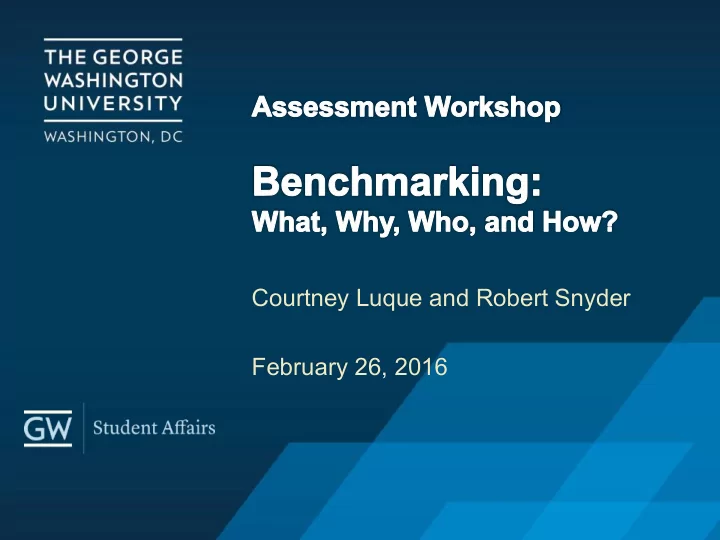

Courtney Luque and Robert Snyder February 26, 2016
Welcome! • Introductions • Courtney Luque, International Student Advisor, International Services Office (cluque@gwu.edu) • Robert Snyder, Executive Director, DSA Planning and Outreach (rsnyder@gwu.edu) • Learning Outcomes • Participants will be able to … … define benchmarking and its importance to their work. … explain the process of benchmarking. … apply benchmarking practices to at least one project on which they are working. … relate benchmarking knowledge gained in this workshop to future projects in their department.
How Can We Use Assessment in DSA? • Understand the needs of our stakeholders, especially students and parents • Validate our - #onlyatgw – strengths • Align with national best practices, professional standards, and academic program evaluation methods • Guide continuous improvement and strategic decision-making • Amplify the case for philanthropic and university financial support • Advocate for enhanced services and programs
What is benchmarking? YOUR PERSPECTIVES
What is benchmarking? (as defined) • “A structural approach for looking outside an organization to study and adapt the best outside practices to complement internal operations with new, creative ideas” (Schuler, 1998, p. 40) • Discovery of promising practices (Newcomer, 2012) • An opportunity to “...diagnose problems in performance and to identify areas of strength” (Schofield, 1998, p. 14) • Validate our practices and solicit external perspectives (Alstete, 1996)
Preparing to benchmark • Why are you benchmarking? • Purpose • Need(s) • Desired outcome(s) • Three types of benchmarking (Upcraft & Schuh, 1996) • Internal (other departments at GW) • Competitive (best practices in the marketbasket) • Generic (off-list/best practices in the field)
Conducting background research • Web searches • GW Libraries • Education Advisory Board • Professional standards (CAS, NASPA/ACPA, etc.) • Professional associations / listservs • Professional / personal contacts • Colleague referrals • Convenience • Consider personal / professional travel, including conferences
Defining market basket • What is a market basket? • Colleges and universities with which GW is most frequently compared and/or to which GW aspires • How do you use a market basket list? • GW’s market basket list • Generic/off-list schools
GW’s Market Basket Schools • American University • Southern Methodist University* • Boston University* • Tufts University* • Duke University • Tulane University* • Emory University • University of Miami* • Georgetown University • University of Pennsylvania • New York University* • University of Rochester • Northeastern University* • University of Southern California • Northwestern University • Vanderbilt University • Syracuse University* • Washington University in St. Louis *Also members of the Colonial Group, which also includes Boston College, Brandeis University, Lehigh University, University of Notre Dame, and Wake Forest University
Developing questions • Who to include in the conversation and roles? • Leadership • Staff • Interested colleagues • Students? • Develop a written list of questions • Build on information from background research • Test GW ideas • Seek feedback on questions • Ask interested GW colleagues (including leadership) before finalizing
Contacting institutions • Initial request for benchmarking (via email) • Purpose • Likely participants • Desired approach (phone, Skype/web conference, in person) • Send information in advance • Questions • Relevant GW information • Confirmed participants
Having the conversation • Roles • Facilitator • Participant • Note taker • Conversation using written questions • “What can we do for you?” • Follow up items • Any additional information requests Thank you note •
Using the results • Share the notes • Include additional information from follow up conversations • What did we learn from this experience? • For this effort? • For other efforts in DSA/at GW?
Now that you know more about benchmarking … • What else do you want to know about benchmarking? • How will you use the information? • What topics/projects do you have in mind? • How will you share this presentation with your colleagues?
References and Additional Reading • Alstete, J. (1996). Benchmarking in Higher Education ASHE-ERIC Higher Education Report No. 5. Washington, D.C.: The George Washington University Graduate School of Education and Human Development. • Culp, M. M., & Dungy, G. J. (2012). Building a Culture of Evidence in Student Affairs: A Guide for Leaders and Practitioners. Washington, DC: National Association of Student Personnel Administrators. • Newcomer, K. (2012). Building Capacity to Measure, Analyze and Evaluate Government Performance. Retrieved from: http://www.lib.noaa.gov/about/ news/newcomer_sep192012.pdf • Schofield, A. (1998). Benchmarking in Higher Education: an International Review . London: Commonwealth Higher Education Management Service (CHEMS). • Schuh, J., & Upcraft, M. (1996). Assessment in Student Affairs: A Guide for Practitioners . San Francisco: Jossey-Bass. • Schuler, R. (1998). Managing Human Resources . (6th ed.) Cincinnati, Ohio: South- Western College Publications. Education Advisory Board
Courtney Luque and Robert Snyder February 26, 2016
Recommend
More recommend